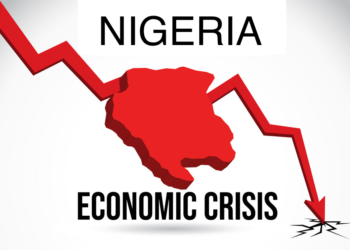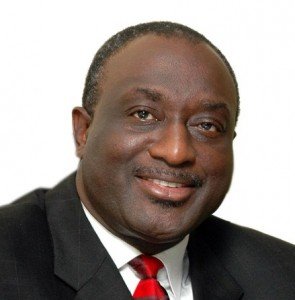The Bank of Ghana has increased its Monetary Policy Rate for the second time this year.
It increased the rate to 19 from 18 percent.
Speaking at a press conference after the Monetary Policy Committee meeting, Governor Dr. Kofi Wampah says they had to increase the rate because of the negative outlook on government’s revenues and spending.
The Governor however puts the Ghana cedi’s rate of depreciation at 26 percent, adding that the pace of depreciation has slowed down.
Below is the full statement
You are welcome to this press briefing. The Monetary Policy Committee (MPC) held its 60th meeting to review developments in the economy and assess risks to the outlook. I present to you excerpts of the deliberations that led to the positioning of the policy rate.
Global Developments
1. The global economy continued its gradual recovery process in the year, despite some moderation in the first quarter. Growth is expected to pick up bolstered by the strong policy actions including banking and financial sector reforms, and improved labour market conditions in the advanced economies.
2. The IMF’s April World Economic Outlook projects global GDP growth at 3.6 percent for 2014 from 3 percent in 2013. The major impulse will come from advanced economies which are projected to grow at 2.2 percent in 2014 from 1.3 percent in 2013. The outlook for emerging and developing countries is for a modest growth of 4.9 percent partly due to tightening financial conditions. The GDP growth for Sub-Saharan Africa is projected to firm at 5.4 percent, up from 4.9 percent in 2013, driven by domestic demand on the back of investments in mining and infrastructure.
3. Global inflation remains subdued on account of declines in commodity prices, especially fuels and food. In advanced economies, the low inflation is generally driven by low economic activity which remains below potential output. This contrasts with steady increases in inflation across most emerging and developing economies. The recent exchange rate depreciations have contributed significantly to inflation pressures in a number of emerging and developing countries, including Ghana.
4. On the international commodities market, price developments were mixed in the first half of the year. Gold prices were bearish hovering around US$1,300 per fine ounce while cocoa prices have improved to about US$3,000 per tonne. In the outlook, gold prices are expected to remain flat on account of liquidity needs by emerging market central banks and continued global disinflation. Cocoa prices are projected to remain bullish boosted by increased demand as the global economy picks up and an anticipated global deficit in the 2014/15 season. Crude oil prices for the rest of the year are underpinned by bearish fundamentals as production levels are projected to exceed demand in the next two years. But these could be countered by oil supply disruptions in some major producing countries and increased demand from China and the US.
The Domestic Economy
• Growth and Inflation
5. Economic activity remained fairly strong in the first quarter of 2014 despite adverse supply side shocks. The Bank’s Real Composite Index of Economic Activity (RCIEA) rose by 9.7 percent on a year-on-year basis in the first quarter, compared with 0.5 percent growth in the same period of 2013. The major growth drivers were Domestic VAT and Deposit Money Banks’ (DMBs) credit to the private sector.
6. The Bank’s CIEA trends were consistent with the recent release by the Ghana Statistical Service which estimated real GDP growth at 6.7 percent year-on-year in the first quarter of 2014 compared with 9 percent same period last year. This was driven by the Agricultural sector with the highest year-on-year growth of 12.7 percent and Services with 4.6 percent. Industry however contracted by 1.1 percent dragged down by negative growth in the manufacturing sub-sector.
7. The Bank’s surveys conducted in March and May 2014 showed further softening of Business and Consumer Confidence alongside heightened inflation expectations. The Business Confidence Index declined to 82.8 in March 2014 from 99.0 in December 2013 as businesses anticipated slowdown in industry growth, sales, revenues and capital outlays due to exchange rate depreciation and high cost of operations. Similarly, the Consumer Confidence Index fell to 76.1 in May 2014 from 81.9 in February explained by softened consumer sentiments on employment prospects, household financial conditions and general economic outlook.
8. Headline Inflation reached 14.8 percent in May 2014 from 13.5 percent in December 2013. Food inflation rose to 8 percent from 7.2 percent while Non-food inflation increased to 20 percent from 18.1 percent over the same period. The upward trajectory of inflation mostly reflects the pass-through of adjustments in domestic petroleum prices, increased utility tariffs and transportation costs, and cedi depreciation.
• Money and Banking Sector Developments
9. Key monetary aggregates grew at a rapid pace driven largely by Net Domestic Assets of the banking sector. Broad money (M2+) grew by 30.8 percent year-on-year to end May 2014 at GH¢22.8 billion, compared with 17.1 percent growth in the same period last year. Similarly, annual growth in Reserve money was 38.2 percent in May 2014, compared with 24.5 percent growth in May 2013.
10. Private sector credit went up by 47.2 percent year-on-year to GH¢18.9 billion in May 2014, compared with 31.2 percent in May 2013. In real terms, the annual growth in credit to the private sector was 28.2 percent at end-May 2014, against 18.4 percent a year earlier. The rapid expansion in credit allocation by banks was funded largely from increased deposits.
11. The banking sector remains sound and continues to expand, evidenced by strong asset growth. Total assets grew by 44.4 percent year-on-year to GH¢42.9 billion at end-May 2014, compared with GH¢32.1 billion a year ago. The asset growth was on the back of advances, which accounted for 45.1 percent and was funded largely by deposits which went up by 32.5 percent year-on-year.
12. Non-Performing Loans (NPLs) ratio declined to 12.8 percent in May 2014 compared to 13.4 percent in May 2013. However, NPLs (less loss provisioning) ratio remained broadly unchanged at 5.3 percent. The Capital Adequacy Ratio of banks declined to 16.7 percent in May 2014, from 18.1 percent in May 2013 on account of increased credit delivery but remained above the regulatory benchmark of 10 percent.
13. However, the credit conditions survey conducted in June 2014 suggests tightening of credit stance for most loan types including consumer credit, SMEs, large enterprises and short-term loans.
14. Interest rates on the money market generally moved upwards in tandem with the Bank’s tight monetary policy stance. Between December 2013 and May 2014,
• The 91-day Treasury bill rate moved from 19.2 percent to 24.1 percent;
• The 182-day Treasury bill rate rose from 18.7 percent to 21.3 percent;
• The 1-year note went up from 17 percent to 22.5 percent
• The 2-year note increased from 16.8 percent to 23 percent
• The 3-year bond increased from 19.2 percent to 25.5 percent, this has however gone down to 24.4 percent in June.
• The 5-year bond increased from 19 percent to 23 percent.
15. The weighted average interbank rate increased from 16.3 percent in December 2013 to 24 percent in May 2014.
16. The average lending rates of banks rose to 27.9 percent in May 2014 from 25.6 percent in December 2013. The average rate on 3-month term deposits remained unchanged at 12.5 percent.
• Government Fiscal Operations
17. Provisional data on Government fiscal operations indicate lower than budgeted outturns for both revenues and expenditures for the period January to May 2014.
• Total revenue and grants for the review period was GH¢9 billion (8.5% of GDP), below the target of GH¢9.5 billion (9% of GDP). Total tax revenue amounted to GH¢7.1 billion, lower than the estimated GH¢7.3 billion. Non-tax revenue outturn was almost in line with projected estimates at GH¢1.8 billion, driven mainly by oil revenues. Grant disbursements remained low at GH¢79.4 million, against an estimated GH¢393.3 million.
• The underperformance of government revenues during the first five months of the year was partly attributed to low import volumes, declines in international gold prices and production which affected mining sector corporate taxes and mineral royalties, and the general slowdown in economic activities.
• Government expenditures (including arrears clearance) amounted to GH¢13.1 billion (12.5% of GDP), lower than the estimated GH¢13.6 billion (12.9% of GDP) for the period. Of the total expenditures, compensation of employees amounted to GH¢4.1 billion against a target of GH¢4.4 billion. Although compensation of employees fell short of target, it constituted about 47 percent of domestic revenues, up from 44.1 percent in the same period of 2013. Interest payments amounted to GH¢2.8 billion, compared with a target of GH¢2.2 billion.
• These fiscal developments resulted in a deficit of GH¢4.12 billion (3.9% of GDP), almost at par with the estimated GH¢4.1 billion (3.8% of GDP) for the period. In the corresponding period of 2013, the fiscal deficit was GH¢3.8 billion (4% of GDP). The budget deficit was largely financed from domestic sources, with Net Domestic Financing of GH¢3.2 billion, against an estimated GH¢3.0 billion.
18. Total stock of public debt (domestic and external) stood at GH¢58.4 billion (55.4% of GDP) at end-March 2014 from GH¢52.1 billion at the end of December 2013. Of the total, the domestic debt component was GH¢27.8 billion (47.5% of total).
• External Sector Developments
19. Provisional estimates indicate that the merchandise trade deficit for the period January to May 2014 contracted sharply on the back of a significant decline in imports, outpacing the slowdown in exports.
20. Total merchandise exports was US$5.9 billion, down by 7.5 percent from the US$6.3 billion recorded in the same period of 2013. This was mainly due to lower earnings in gold and crude oil.
• Gold exports amounted to US$1.8 billion as both gold prices and volumes fell by 17 and 7 percent year-on-year respectively. This compares with gold export earnings of US$2.3 billion in the corresponding period of 2013.
• Cocoa beans and products amounted to US$1.5 billion compared with US$1.3 billion for 2013, representing a growth of 14.4 percent.
• Crude oil exports declined to US$1.6 billion from US$1.7 billion in 2013 on the back of lower production volumes which fell by 8 percent although prices inched up marginally by 1.3 percent.
• Non-traditional export earnings (including timber and other minerals) remained unchanged at US$1 billion.
21. Total imports declined to US$6 billion for the period under review, down by 17.8 percent compared with US$7.3 billion in same period of 2013. This was attributed to a 19.7 percent year-on-year decline in Non-oil imports to US$4.6 billion while Oil imports fell by 11 percent to US$1.4 billion.
22. The trade deficit therefore narrowed significantly to US$156.6 million from January to May 2014, compared with a deficit of US$990.8 million in the corresponding period of 2013.
23. Total remittances to individuals increased to US$692 million in January to May 2014 from US$652 million in the same period of 2013.
24. Developments in the foreign exchange market indicated that the cedi cumulatively depreciated by 26.7 percent against the US dollar in the first half of 2014 compared with 3.4 percent depreciation same period last year.
25. Gross International Reserves (GIR) at end-June 2014 was US$4.5 billion, corresponding to 2.5 months of import cover, compared with US$5.6 billion at end-December 2013. This development partly reflects the seasonality in foreign exchange flows during the year.
Summary and Outlook
26. In discussing the risks to inflation and growth, the Committee observed that global conditions remain fragile underscored by tightening of financial conditions and softening commodity prices. The weak prices of gold, in particular, have resulted in lower production volumes posing risks to the external and fiscal outlook. The Committee is monitoring these developments and its impact through the trade and financial channels.
27. On the domestic economy, the Committee noted that the risks to the fiscal outlook have increased on account of underperformance of government revenues, the rising share of compensation of employees in domestic revenues and the increasing difficulty of raising financing from traditional sources. The situation is further compounded by the emergence of subsidies due to delays in adjustment of petroleum and utility prices, build-up of arrears particularly on statutory payments, delays in the implementation of some revenue measures outlined in the 2014 budget and slow disbursement of program grants.
28. Fiscal consolidation would require a more aggressive stance in the second half of 2014. Government must continue to enhance revenue measures and rationalise expenditures to achieve the fiscal deficit target of 8.5 percent of GDP for the year.
29. On exchange rate developments, pressures on the local currency are still persisting although we have observed some moderation in the pace of depreciation on a month-on-month basis. The pressures are of major concern due to the adverse consequences of the depreciating currency on the economy. In the outlook however, we anticipate that the proceeds from the cocoa syndicated loan and the Eurobond issuance, estimated at almost US$3 billion would provide significant support for the market in the second half of the year. The onset of gas production in the fourth quarter of the year would also reduce the oil import bill going forward. These developments are expected to help restore the gross international reserves to a minimum of 3 months of import cover.
30. While some of these measures would address the short term challenges, there is the need to continue to put in place medium term policies that would broaden the export base to reduce over reliance on a few primary export commodities. The on-going Government policy to promote specific exports and import substitutes should be expedited. In addition, the coming on stream of the new oil and gas fields in the second half of 2016 will consolidate the medium term outlook.
31. Economic growth has moderated but remains positive. The weakening of both business and consumer confidence, energy sector constraints and rising input costs all pose downside risks to the growth outlook. On the other hand, high private sector credit growth, improved cocoa production and expected addition of gas to the economy should provide some boost to growth conditions in the latter part of 2014 and beyond.
32. Headline inflation, although has slowed on a month-on-month basis, continued to drift further away from the target band underpinned by cost-push factors alongside heightened inflation expectations by businesses and the financial sector. The persisting fiscal and exchange rate pressures have provided additional impetus to the worsening inflation outlook. Other risks related to the inflation outlook include the recent rapid growth in monetary aggregates such as credit to the private sector and money supply. Our latest inflation forecasts which factor in possible petroleum price increases and liquidity conditions show that barring any significant shocks, inflation is likely to return to the target range of 9.5±2 percent by the last quarter of 2015.
33. On the balance therefore, the Committee viewed risks to inflation as elevated and decided to increase the policy rate by 100 basis points to 19 percent to contain inflation pressures and realign interest rates in favour of domestic assets. This is in addition to the measures implemented in the previous MPC meeting on reserve requirements and NOPs which are still working through the system.
















